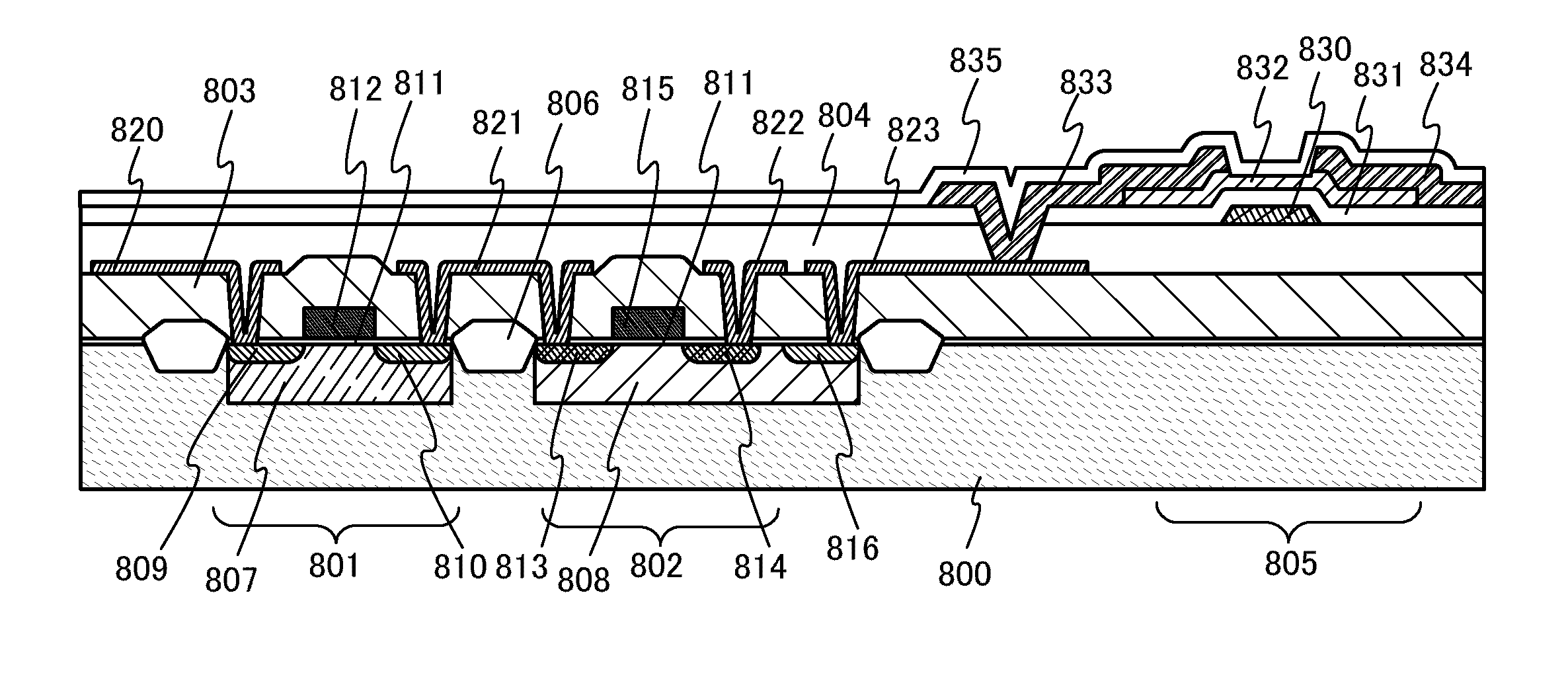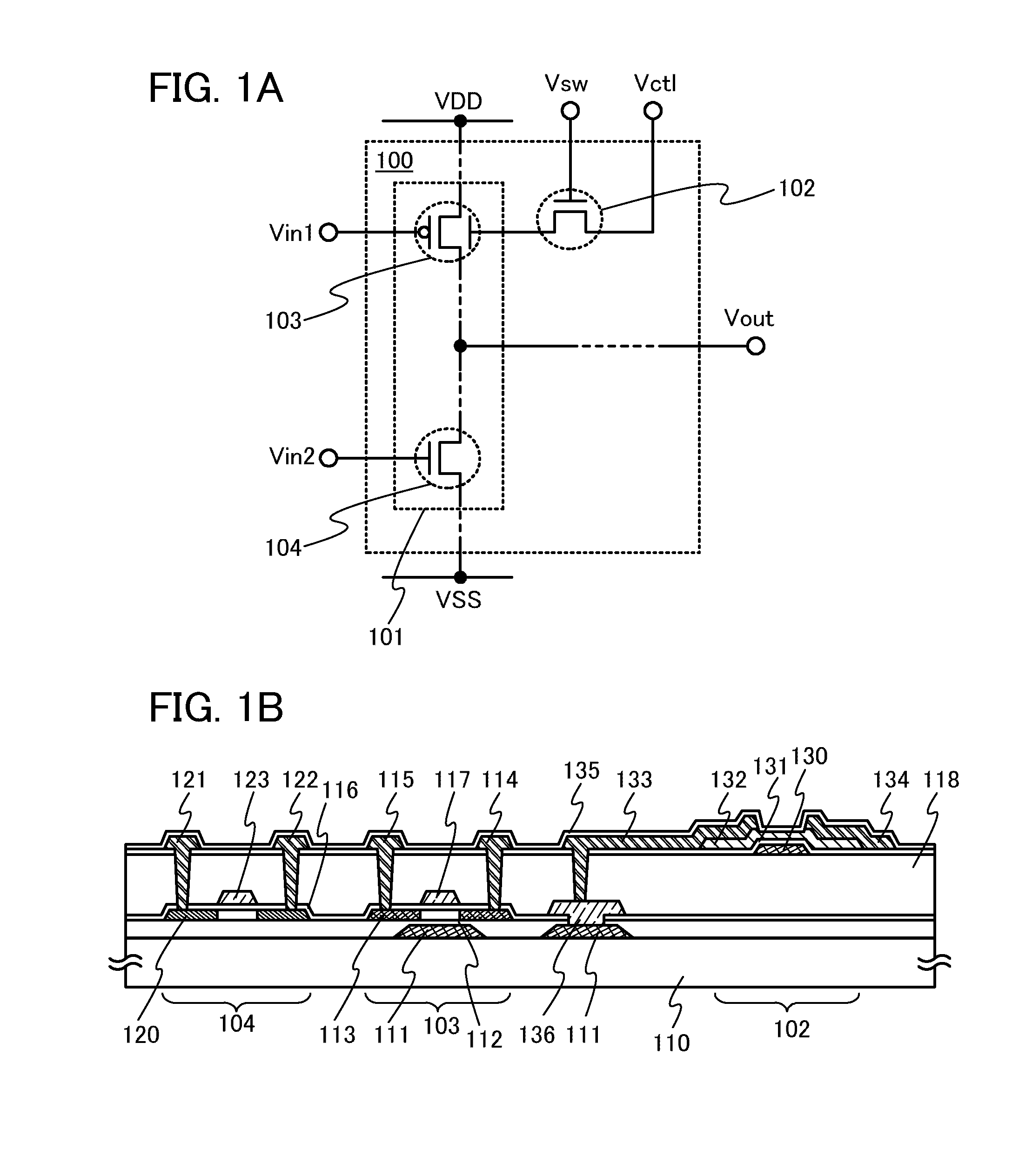Semiconductor device
a technology of semiconductors and devices, applied in the direction of semiconductor devices, electrical equipment, transistors, etc., can solve the problems of increasing power consumption increasing heat generation due to through current, etc., and achieves the effect of suppressing power consumption, low off-state current, and reducing through curren
- Summary
- Abstract
- Description
- Claims
- Application Information
AI Technical Summary
Benefits of technology
Problems solved by technology
Method used
Image
Examples
embodiment 1
[0041]FIG. 1A shows an example of the structure of a logic circuit which is used in a semiconductor device according to one embodiment of the present invention.
[0042]A logic circuit 100 in FIG. 1A includes a logic portion 101 for performing logical operation and a transistor 102 which functions as a switching element. The logic portion 101 includes at least a p-channel transistor 103 and an n-channel transistor 104. In the logic portion101, logical operation to be performed is uniquely determined in accordance with the number and connection structure of the p-channel transistor 103 and the n-channel transistor 104. Then, one output value can be obtained from a plurality of input values by the logical operation which is performed in the logic portion 101.
[0043]Note that the input value means a logical value represented by a potential Vin of an input signal inputted into the logic circuit 100. Further, the output value means a logical value represented by a potential Vout of an output...
embodiment 2
[0092]In this embodiment, another example of the structure of a logic circuit which is used in a semiconductor device according to one embodiment of the present invention will be shown.
[0093]A logic circuit 200 in FIG. 2A includes a logic portion 201 for performing logical operation and a transistor 202 with a low off-state current, which functions as a switching element. The logic portion 201 includes a p-channel transistor 203 and an n-channel transistor 204. FIG. 2A shows, as an example, the case where the logic portion 201 is an inverter including the p-channel transistor 203 and the n-channel transistor 204.
[0094]Specifically, in the logic portion 201, a gate electrode of the p-channel transistor 203 and a gate electrode of the n-channel transistor 204 are connected to each other. A potential Vin of an input signal inputted into the logic circuit 200 is supplied to the gate electrode of the p-channel transistor 203 and the gate electrode of the n-channel transistor 204. Further...
embodiment 3
[0111]In this embodiment, another example of the structure of a logic circuit which is used in a semiconductor device according to one embodiment of the present invention will be shown.
[0112]A logic circuit 300 in FIG. 6A includes a logic portion 301 for performing logical operation and a transistor 302 and a transistor 303 with a low off-state current, which each function as a switching element. The logic portion 301 includes a p-channel transistor 304, a p-channel transistor 305, an n-channel transistor 306, and an n-channel transistor 307. FIG. 6A shows, as an example, the case where the logic portion 301 is a NAND including the p-channel transistor 304, the p-channel transistor 305, the n-channel transistor 306, and the n-channel transistor 307.
[0113]Specifically, in the logic portion 301, a gate electrode of the p-channel transistor 304 and a gate electrode of the n-channel transistor 306 are connected to each other. A potential VinA of an input signal inputted into the logic c...
PUM
 Login to View More
Login to View More Abstract
Description
Claims
Application Information
 Login to View More
Login to View More - R&D
- Intellectual Property
- Life Sciences
- Materials
- Tech Scout
- Unparalleled Data Quality
- Higher Quality Content
- 60% Fewer Hallucinations
Browse by: Latest US Patents, China's latest patents, Technical Efficacy Thesaurus, Application Domain, Technology Topic, Popular Technical Reports.
© 2025 PatSnap. All rights reserved.Legal|Privacy policy|Modern Slavery Act Transparency Statement|Sitemap|About US| Contact US: help@patsnap.com



